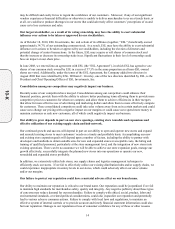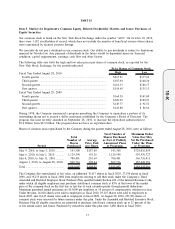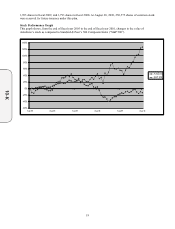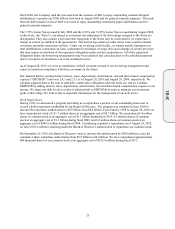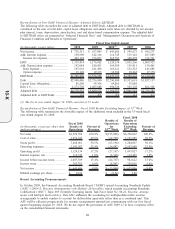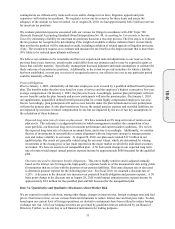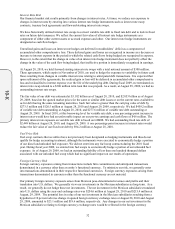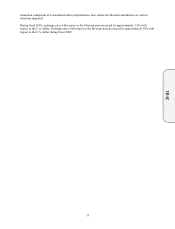AutoZone 2010 Annual Report Download - page 114
Download and view the complete annual report
Please find page 114 of the 2010 AutoZone annual report below. You can navigate through the pages in the report by either clicking on the pages listed below, or by using the keyword search tool below to find specific information within the annual report.
factor their receivables from us. Certain vendors participate in financing arrangements with financial institutions
whereby they factor their receivables from us, allowing them to receive payment on our invoices at a discounted
rate.
Depending on the timing and magnitude of our future investments (either in the form of leased or purchased
properties or acquisitions), we anticipate that we will rely primarily on internally generated funds and available
borrowing capacity to support a majority of our capital expenditures, working capital requirements and stock
repurchases. The balance may be funded through new borrowings. We anticipate that we will be able to obtain
such financing in view of our credit ratings and favorable experiences in the debt markets in the past.
For the fiscal year ended August 28, 2010, our after-tax return on invested capital (“ROIC”) was 27.6% as
compared to 24.4% for the comparable prior year period. ROIC is calculated as after-tax operating profit
(excluding rent charges) divided by average invested capital (which includes a factor to capitalize operating
leases). ROIC increased primarily due to increased after-tax operating profit. We use ROIC to evaluate whether
we are effectively using our capital resources and believe it is an important indicator of our overall operating
performance.
Debt Facilities
In July 2009, we terminated our $1.0 billion revolving credit facility, which was scheduled to expire in fiscal
2010, and replaced it with an $800 million revolving credit facility. This credit facility is available to primarily
support commercial paper borrowings, letters of credit and other short-term unsecured bank loans. The credit
facility may be increased to $1.0 billion at our election and subject to bank credit capacity and approval, may
include up to $200 million in letters of credit, and may include up to $100 million in capital leases each fiscal
year. As the available balance is reduced by commercial paper borrowings and certain outstanding letters of
credit, we had $331.1 million in available capacity under this facility at August 28, 2010. Under the revolving
credit facility, we may borrow funds consisting of Eurodollar loans or base rate loans. Interest accrues on
Eurodollar loans at a defined Eurodollar rate, defined as the London InterBank Offered Rate (“LIBOR”) plus the
applicable percentage, which could range from 150 basis points to 450 basis points, depending upon our senior
unsecured (non-credit enhanced) long-term debt rating. Interest accrues on base rate loans at the prime rate. We
also have the option to borrow funds under the terms of a swingline loan subfacility. The revolving credit facility
expires in July 2012.
The revolving credit facility agreement requires that our consolidated interest coverage ratio as of the last day of
each quarter shall be no less than 2.50:1. This ratio is defined as the ratio of (i) consolidated earnings before
interest, taxes and rents to (ii) consolidated interest expense plus consolidated rents. Our consolidated interest
coverage ratio as of August 28, 2010 was 4.27:1.
In June 2010, we entered into a letter of credit facility that allows us to request the participating bank to issue
letters of credit on our behalf up to an aggregate amount of $100 million. The letter of credit facility is in addition
to the letters of credit that may be issued under the revolving credit facility. As of August 28, 2010, we have
$100.0 million in letters of credit outstanding under the letter of credit facility, which expires in June 2013.
During August 2009, we elected to prepay, without penalty, the $300 million bank term loan entered in December
2004, and subsequently amended. The term loan facility provided for a term loan, which consisted of, at our
election, base rate loans, Eurodollar loans or a combination thereof. The entire unpaid principal amount of the
term loan would be due and payable in full on December 23, 2009, when the facility was scheduled to terminate.
Interest accrued on base rate loans at a base rate per annum equal to the higher of the prime rate or the Federal
Funds Rate plus 1/2 of 1%. We entered into an interest rate swap agreement on December 29, 2004, to effectively
fix, based on current debt ratings, the interest rate of the term loan at 4.4%. The outstanding liability associated
with the interest rate swap totaled $3.6 million, and was expensed in operating, selling, general and administrative
expenses upon termination of the hedge in fiscal 2009.
On July 2, 2009, we issued $500 million in 5.75% Senior Notes due 2015 under our shelf registration statement
filed with the Securities and Exchange Commission on July 29, 2008 (the “Shelf Registration”). Also, on
August 4, 2008, we issued $500 million in 6.50% Senior Notes due 2014 and $250 million in 7.125% Senior
Notes due 2018 under the Shelf Registration. The Shelf Registration allows us to sell an indeterminate amount in
debt securities to fund general corporate purposes, including repaying, redeeming or repurchasing outstanding
debt and for working capital, capital expenditures, new store openings, stock repurchases and acquisitions. In
24
10-K


